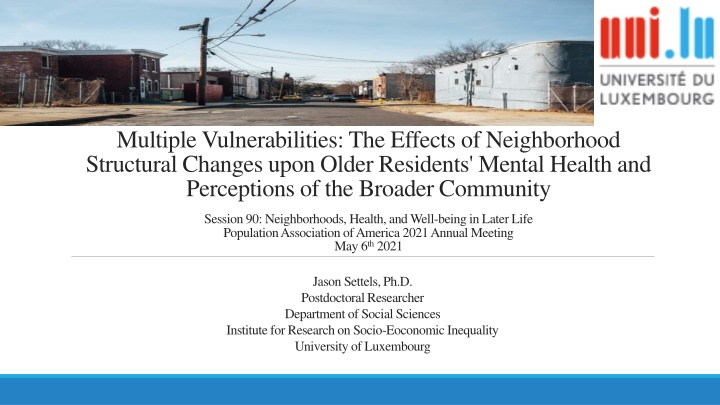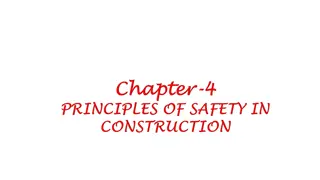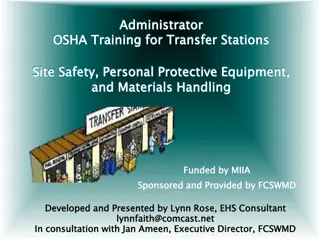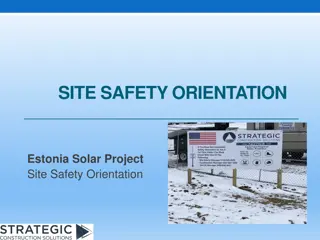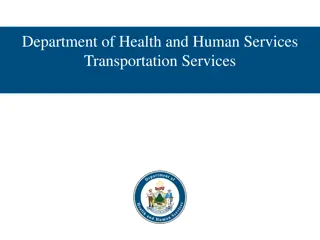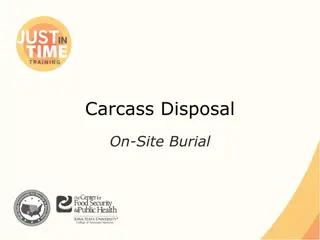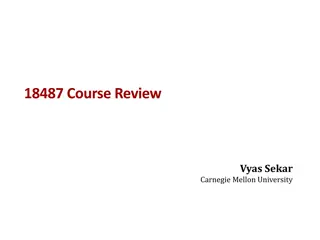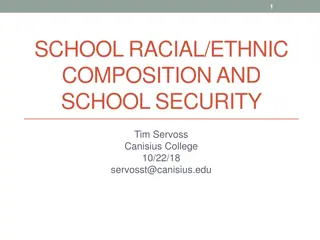Site Security and Safety Measures
This content discusses the importance of site security, protection measures, guards and access controls, emergency procedures, fire safety precautions, and responding to fires. It emphasizes implementing a combination of physical and procedural layers to ensure a secure workplace for everyone.
Download Presentation

Please find below an Image/Link to download the presentation.
The content on the website is provided AS IS for your information and personal use only. It may not be sold, licensed, or shared on other websites without obtaining consent from the author.If you encounter any issues during the download, it is possible that the publisher has removed the file from their server.
You are allowed to download the files provided on this website for personal or commercial use, subject to the condition that they are used lawfully. All files are the property of their respective owners.
The content on the website is provided AS IS for your information and personal use only. It may not be sold, licensed, or shared on other websites without obtaining consent from the author.
E N D
Presentation Transcript
Multiple Vulnerabilities: The Effects of Neighborhood Structural Changes upon Older Residents' Mental Health and Perceptions of the Broader Community Session 90: Neighborhoods, Health, and Well-being in Later Life Population Association of America 2021 Annual Meeting May 6th2021 Jason Settels, Ph.D. Postdoctoral Researcher Departmentof Social Sciences Institute for Researchon Socio-EoconomicInequality Universityof Luxembourg
Introduction Introduction Neighborhood impacts might be stronger among older populations (Bromell & Cagney, 2014). Scholarship further shows how neighborhoods structural, or socioeconomic, conditions impact their overall social circumstances and solidarity ( overall neighborhood social capital ), presenting some likely mechanisms through which neighborhoods affect health and well-being (York Cornwell & Cagney, 2014). Further research attention should be paid to neighborhood social capital s multi-dimensionality. The present study helps fill a research gap through a longitudinal investigation of neighborhood structural impacts upon residents depressive symptoms and stress, as well as the three measures of neighborhood social capital (social cohesion, social ties, and safety) developed by York Cornwell and Cagney (2014), within a sample of older adults, Social disorganization theory (Sampson & Groves, 1989).
Introduction Introduction Research question 1: How do changing neighborhood socioeconomic conditions affect older residents mental health? Hypothesis: Based on social disorganization theory, it is hypothesized that worsening neighborhood structural conditions lead to depression and stress among older residents. Research questions 2: How do changing neighborhood socioeconomic conditions affect older residents perceptions of various dimensions of neighborhood social capital? Hypotheses: Informed by social disorganization theory, it is hypothesized that declining communities older residents will report lower extents of neighborhood social cohesion and safety. Informed by Stack (1974), it is hypothesized that widespread need for instrumental and emotional support within declining communities implies that their older residents will not report lower extents of neighborhood social ties.
Introduction Introduction Research question 3: How do relocations to new neighborhoods moderate the impacts of changing neighborhood socioeconomic conditions upon older adults perceptions of neighborhood social capital? Hypotheses: It is hypothesized that lack of experience in a new community will provide less evidence of neighborhood social cohesion and ties, leading to lower reports of these community characteristics. This study further hypothesizes that less familiarity with one s new environment will accentuate fear of crime and violence, causing lower perceptions of neighborhood safety.
Methods Methods The National Social Life, Health, and Aging Project (NSHAP) survey. This study utilized the second (2010-2011) and third (2015-2016) waves (the two most recent waves) because they include a set of eleven diverse subjective assessments of neighborhood social circumstances, or social capital. The analytical sample of participants in both waves of at least 50 years of age at wave 2 is 2,357 respondents.
Methods Methods Census tracts were here utilized to operationalize neighborhoods (see Estabrooks, Lee, & Gyurcsik, 2003). Protected geodata provided by the National Opinion Research Center at the University of Chicago through special contractual arrangements allowed the association of NSHAP interviewees with their census tracts. The present study included respondents from 691 census tracts at wave 2. The 2006-2010 and 2011-2015 American Community Surveys (ACS) provided census tract-level data for the second and third waves, respectively. Central independent variable is an index of census tract-level socioeconomic disadvantage: Percentage of adults unemployed Percentage of households on public assistance Percentage of persons whose incomes are below the poverty line All three scores were standardized (to place them all on the same scale) before being averaged, separately by wave (Cronbach s alphas: wave 2 = 0.76, wave 3 = 0.79).
Methods Methods Mental health dependent variables Depressive symptoms The 11-item short form version of the 20-item Center for Epidemiologic Studies Depression Scale (CES-D) How often in the previous week respondents felt depressed, their sleep was restless, people were unfriendly, they felt sad, etc. Possible answers were (1) rarely or none of the time, (2) some of the time, (3) occasionally, or (4) most of the time. To produce this index, the eleven answers were averaged within the second and third waves (Cronbach s alphas: wave 2 = 0.79, wave 3 = 0.82).
Methods Methods Stress The four items within the scale of perceived social stress are a subgroup of items from Cohen s Perceived Stress Scale (Cohen, Kamarck, & Mermelstein, 1983). Regarding previous week, respondents were asked how often they felt: unable to control important things confident about my ability (reverse coded) things are going my way (reverse coded) difficulties piling up Possible answers were (1) rarely or none of the time, (2) some of the time, (3) occasionally, or (4) most of the time. Averaging the four answers within each wave produced this index. The Cronbach s alphas for this index were less than ideal (wave 2 = 0.58, wave 3 = 0.59).
Methods Methods Neighborhood social capital dependent variables Neighborhood Social Ties 1) how often do people in this area visit? 2) how often do people in this area do favors? 3) how often do people in this area ask advice? (0) never (1) rarely (2) sometimes (3) often Cronbach s alphas: wave 2 = 0.76, wave 3 = 0.79.
Methods Methods Neighborhood Social Cohesion 1) this is a close-knit area 2) people around here are willing to help 3) people in this area don't get along (reverse coded) 4) people in this area don't share same values (reverse coded) 5) people in this area can be trusted Cronbach s alphas: wave 2 = 0.68, wave 3 = 0.72. 1) 2) 3) Neighborhood Safety people in this area are afraid at night (reverse coded) there are places where trouble is expected (reverse coded) you're taking a big chance walking alone at night (reverse coded) Cronbach s alphas: wave 2 = 0.81, wave 3 = 0.83. (1) strongly disagree (2) disagree (3) neither agree nor disagree (4) agree (5) strongly agree Overall neighborhood social capital, all 11 measures (averaged after being standardized: Cronbach s alphas: wave 2 = 0.77, wave 3 = 0.81).
Methods Methods Moderating variable: Whether a respondent changed census tracts between the two waves. Control variables: Census tract-level population density residential instability Individual-level (only with the depressive symptoms and stress individual-level dependent variables) employment status marital/relationship status total household assets household s total income in the previous year Fixed-effects linear regression analyses. Further modelling details. See Hawkley, Kocherginsky, Wong, Kim, & Cagney (2014) for inverse probability weighting technique.
Results Results
Results Results
Discussion Discussion This study encourages explorations of the effects of contexts across the entire life course. This study confirms within an older sample that neighborhoods characteristics affect symptoms of stress and depression. As such, this study s first hypothesis is confirmed.
Discussion Discussion The three scales of neighborhood social capital here studied show unique dynamics as neighborhood structural conditions change. Neighborhood social cohesion decreases with rising census tract socioeconomic disadvantage. This finding is concordant with what was hypothesized. However, increasing census tract socioeconomic disadvantage is not significantly associated with decreasing neighborhood social ties. This also is in agreement with what was hypothesized.
Discussion Discussion Rising census tract socioeconomic disadvantage is associated with lower perceptions of neighborhood safety only among older persons who relocated to a new census tract. This contradicts the hypothesis that rising census tract socioeconomic disadvantage generally decreases perceptions of neighborhood safety. However, it confirms the hypothesis that the negative effects of increased census tract socioeconomic disadvantage upon perceived neighborhood safety are stronger among those who moved to a new census tract.
Discussion Discussion In addition to significant effects upon depressive symptoms and stress, worsening census tract socioeconomic conditions negatively affected perceptions of overall neighborhood social capital, neighborhood social cohesion, and neighborhood safety (among those relocating to new census tracts). The latter are highly consequential for quality of life as they denote the extent to which residents trust that their communities are close-knit and supportive, while providing them with the opportunities for health-promoting physical, social, and cognitive activity, as well as the safety that will allow them to live happily and comfortably.
Discussion Discussion One limitation is this study s timespan of only five to six years. As neighborhoods change only gradually, a longer time span is likely required to assess the full effects of neighborhood socioeconomic changes upon residents perceptions of various dimensions of neighborhood social capital. Especially within neighborhoods undergoing structural declines, efforts and resources should be dedicated to the development of social foci (see Feld, 1981), including community centers, senior centers, exercise facilities and programs, hobby groups, etc., around which social activities and relationships are developed, thus improving numerous dimensions of community social capital.
References References Bromell, L., & Cagney, K. A. (2014). Companionship in the Neighborhood Context. Research on Aging, 36(2), 228 243. https://doi.org/10.1177/0164027512475096 Cohen, S., Kamarck, T., & Mermelstein, R. (1983). A global measure of perceived stress. Journal of health and social behavior, 24(4), 385-396. Estabrooks, P. A., Lee, R. E., & Gyurcsik, N. C. (2003). Resources for physical activity participation: Does availability and accessibility differ by neighborhood socioeconomic status? Annals of Behavioral Medicine, 25(2), 100 104. https://doi.org/10.1207/S15324796ABM2502_05 Feld, S. L. (1981). The focused organization of social ties. American journal of sociology, 86(5), 1015-1035. Hawkley, L. C., Kocherginsky, M., Wong, J., Kim, J., & Cagney, K. A. (2014). Missing data in wave 2 of NSHAP: Prevalence, predictors, and recommended treatment. Journals of Gerontology - Series B Psychological Sciences and Social Sciences, 69, S38 S50. https://doi.org/10.1093/geronb/gbu044 Sampson, R. J., & Groves, W. B. (1989). Community structure and crime: Testing social-disorganization theory. American journal of sociology, 94(4), 774-802. http://dx.doi.org/10.1086/229068 Stack, C. B. (1974). All our kin. New York, NY: Basic Books. York Cornwell, E., & Cagney, K. A. (2014). Assessment of neighborhood context in a nationally representative study. Journals of Gerontology - Series B Psychological Sciences and Social Sciences, 69, S51 S63. https://doi.org/10.1093/geronb/gbu052
Thank you! jason.settels@uni.lu
